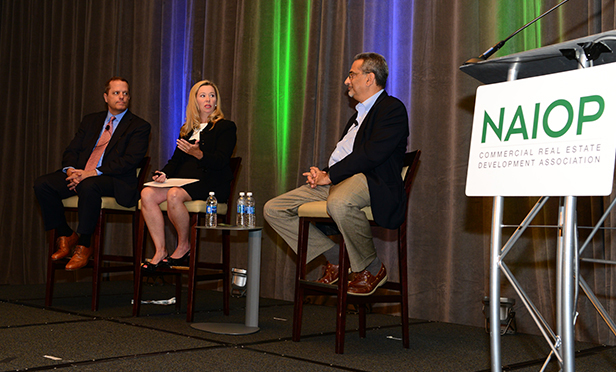 Left to right: Ben Conwell Sr., Kelly Picard, Curtis Spencer
Left to right: Ben Conwell Sr., Kelly Picard, Curtis Spencer
JERSEY CITY, NJ—Winners in the battle for online consumers will be the companies that control costs while keeping customer satisfaction high, say panelists at this month’s NAIOP I.CON: Trends and Forecasts conference in Jersey City, NJ.
During the “E-Commerce Last Mile” discussion, panelists Curtis Spencer, president of IMS Worldwide; Ben Conwell Sr., managing director, Cushman & Wakefield; and Kelly Picard, CEO of Hackbarth Delivery Service, say the growth in e-commerce makes the last mile of delivery especially critical. Last mile refers to the final travels of a purchase from a distribution center to the customer, and is often characterized in terms of delivery speed in days or hours.
For Amazon.com, the last mile means 2 to 4 hours, says Spencer, who showed images of a one million square foot Amazon distribution center. “It’s all in the brains, the IP, that Amazon started doing. They’re really more of a logistics company than a sales company,” he says. For others, last mile means if customers order by noon, the purchase will be delivered by 8 p.m., he says.
By 2020, panelists noted, cross-border e-commerce will sell $486 billion in US goods, and US consumers will buy $140 billion from overseas. The growth will generate demand for 160 new e-commerce logistics centers of 800,000 square feet or more in the top urban markets.
Recalling the home milk deliveries of the 1950s and 1960s, Picard noted that the resurgence of food delivery e-commerce options is not really new. “It’s not something that had ever gone away completely,” she says. In the early- to mid-1990s, her firm provided home delivery of groceries in smaller markets in the Southeast. “They didn’t make it because of this little thing called ‘willingness to pay,’” she says. “I think there has to be a willingness to pay for a higher level of service, and if Amazon wants to become profitable on its free delivery model, there’s no such thing as a free delivery.”
Retailers are moving to create an omnichannel approach to sales, Picard says, where customers have a seamless shopping experience that integrates online shopping from a desktop, mobile device, telephone or in a brick-and-mortar store. Perishable goods, consumables, durables and even vehicles are sold through omnichannel strategies, she says.
Free shipping from an e-commerce vendor like Zappos.com is convenient and more attractive to many shoppers than the occasional sale prices offered by stores like Macy’s, even though Zappos.com doesn’t offer many discounts, she says.
Profit margins from online sales shipped from a large distribution center are much higher than in traditional carriage trade store locations, Spencer says. “What is the cost for Macy’s New York per square foot?” he asked. “$100 a square foot, $500 a square foot? That shoe takes up some space there vs. a warehouse for $5 a square foot. There’s a lot more margin selling that shoe out of the warehouse than at Macy’s downtown.”
“You can pay for a whole lot of free delivery by not selling at a discount and not paying that retail per square foot price,” Picard agreed. “The winners in this space are going to be those who can control costs while achieving that high customer satisfaction.”
Traditional brick-and-mortar retailers are going to be players, too, she says.
Walmart is repositioning itself to be a key player in e-commerce distribution, Picard says. “In the last year or two, Walmart has been quietly building large fulfillment centers where they can hit 96 percent of the US population in two days. Walmart also has one of the largest private fleets of tractor-trailers in the country. That’s an asset they can leverage to help with the transportation cost.”
“Managing all that inventory is a completely new set of calculations now than it was five or ten years ago,” says Cushman & Wakefield’s Conwell, noting that the last mile is the key piece of the logistics puzzle. “Whoever figures out the last mile in a cost-effective and timely way wins the game. That’s the last, most intimate, and critical touch with the customer.”

















 Copyright © 2024 ALM Global, LLC. All Rights Reserved.
Copyright © 2024 ALM Global, LLC. All Rights Reserved.